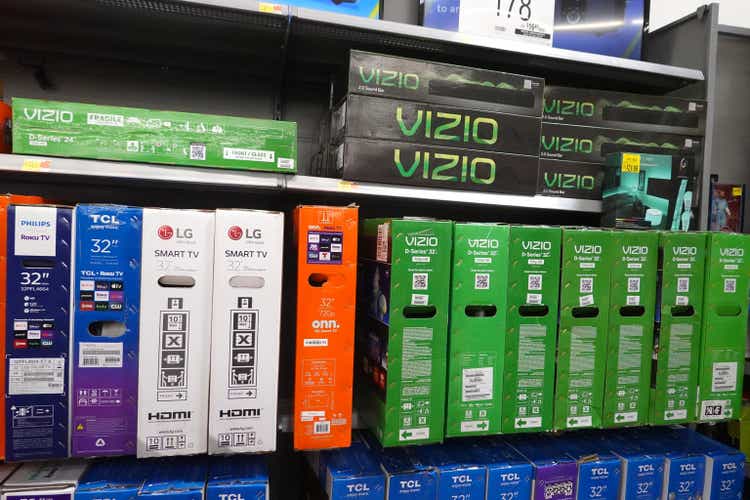Scott Olson/Getty Images News
In March of last year I concluded that VIZIO Holding (NYSE:VZIO) provided entertainment, potentially for the portfolio as well. The company went public at the time, a period in which technology names, and recent public offerings, saw a pullback. Amidst all of this, I was looking to set up a small relative value play in the wake of the initial offering.
Quick Recap
The story behind Vizio was kind of special. After founder William Wang survived a plane crash, he realized his love for home. With that in mind, Vizio was created.
The idea is that home should be everyone’s favorite place and that home entertainment should become accessible for everyone. The center of this is the Vizio smart TV, allowing for TV watching, movies, as well as gaming and learning.
The company actually offers smart TVs, complemented by sound bars and the so-called SmartCast operating system, improving the functionality and monetization of the device. In the period 2002-2020 the company sold over 80 million televisions and more than 12 million sound bars, a huge achievement.
Devices are being sold through major retailers like Amazon, Best Buy, Costco, and Walmart, among others, while supporting players in interactive television, including Netflix, Hulu, Disney, and Apple TV. The platform generates revenues from advertising, data licensing and content distribution, thereby benefiting from cord-cutting, as well as other applications for which TVs are used nowadays, including shopping, fitness, and gaming as well.
The company went public at $21 per share, valuating equity at $3.9 billion, or $3.5 billion if we back out net cash holdings. This valuation revealed a modest sales multiple as revenues rose 11% to $2.04 billion in 2020, yet the vast majority of these sales were device/hardware sales, with platform revenues increasing by a spectacular 133% to $147 million.
Operating earnings rose to $132 million, resulting in realistic earnings of around $100 million, equal to just over half a dollar per share as TV sales rose that year following the outbreak of the pandemic. While there was potential for the company to grow and to thereby create a compelling investment case, there were many question marks as well. This includes many changes in the competitive field and constant need to update licensing and partnerships, as this was still a large device business at the time.
Looking at Vizio’s platform operations, the company is on track to generate a quarter of a billion in sales, much smaller than the near $2 billion revenue number of Roku (ROKU) which supported a $41 billion, or 20 times sales multiple, at the time. Vizio trades at just 14 times these revenues, even if I did not attach any value to the device business, making a long Vizio and short Roku position at $400 interesting in my book.
Valuations Come Down
Fast forwarding since the spring of last year, we see shares of Vizio now trade at $10 and change, marking 50% losses over this period of time of nearly one and half a year time, albeit that shares have risen quite a bit from lows of $6 and change. The relative valuation play has certainly played out as shares of Roku trade at $68, down over 80% over this period of time.
In March of this year it turned out that the company grew 2021 sales by a modest 4% to $2.12 billion. Device revenues fell slightly to $1.82 billion, yet platform revenues more than doubled (again) to $309 million, being good for the (gross) margin profile. Despite this margin dynamic, the company posted a GAAP operating loss of $30 million, the result of a $134 million stock-based compensation expense that year.
In May the company posted a 4% fall in first quarter sales to $485 million as a 16% decline in device sales was not offset by a 97% increase in platform revenues, which breached the hundred million mark. GAAP operating losses came in at $13 million on the back of continued stock-based compensation expenses, but even adjusted for a $16 million expense on that front, earnings otherwise would not have been that meaningful.
Second quarter sales rose 2% to 409 million with device sales down 11% as platform revenue growth slowed to 69%, coming in at $111 million. The company has aggressively managed the expense base, having posted a $4 million GAAP operating profit for the quarter, as stock-based compensation expenses were curtailed to $6 million and change.
A share count of 197 million shares now value equity of the business at around $2 billion, including a $335 million net cash position, for an enterprise valuation of roughly $1.7 billion. This values the operations now at less than 1 times sales, yet realistic earnings are quite minimal as well, not translating into any realistic or meaningful earnings multiple.
What Now?
While sales multiples are low, the issue is that this remains largely a device play, as the earning numbers are not that meaningful. The reality is that the outlook for TV sales in the near term is likely not that great as many consumers already spent money to upgrade their TVs during the pandemic, with inflationary pressure hurting consumer spending on non-essentials in all likelihood.
The reality is that the long-term position of this company remains to be seen over time, but the market dynamics makes that entertainment giants could be on the hunch for smart TV deals as well, leaving the company subject to potential takeover interest.
With regard to the Roku pair trade, that position is now closed. Yet despite the fall in the share price, I do not see a great reason to become too upbeat on Vizio just yet. Continued platform growth is to be applauded, but realistic margins have only taken a beating, although I am impressed with the second quarter margin performance, I must say. All of this leaves me to place Vizio on the future watch list, but not actively holding a position here.


Be the first to comment